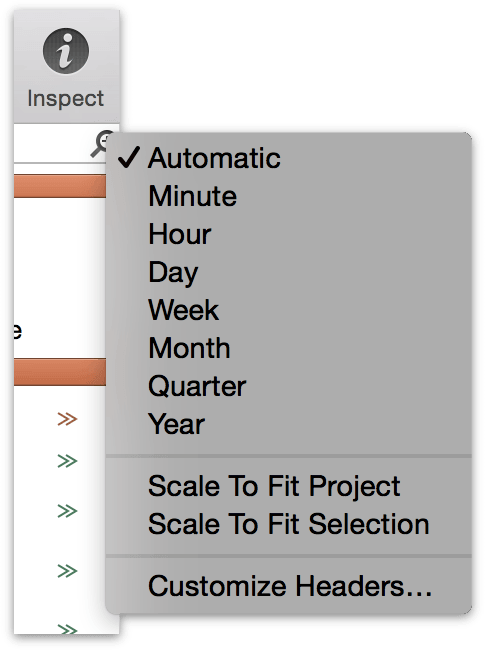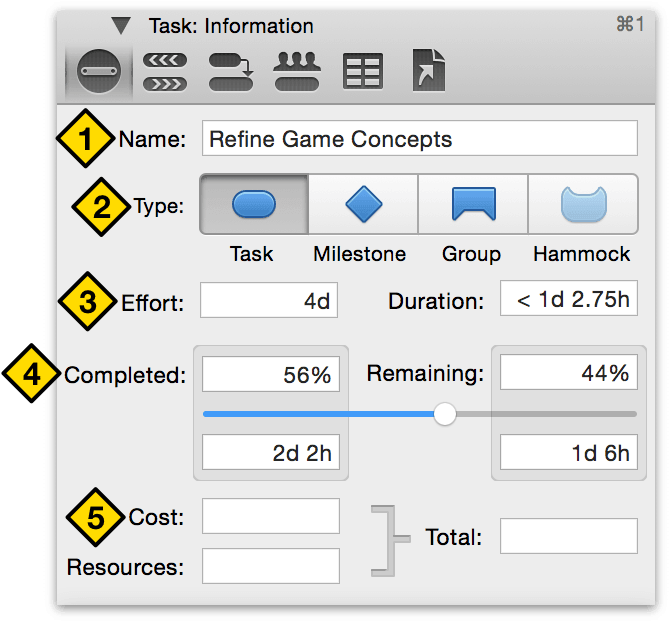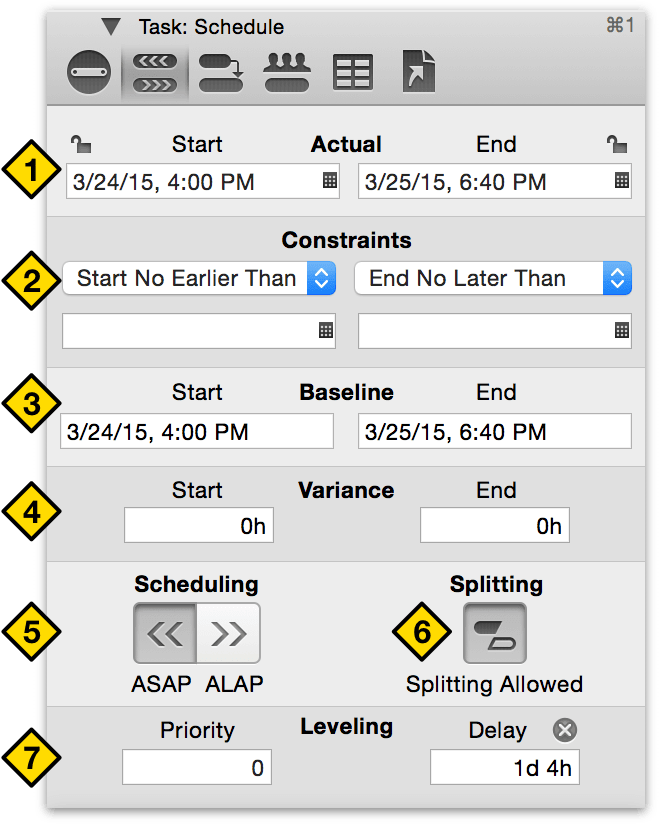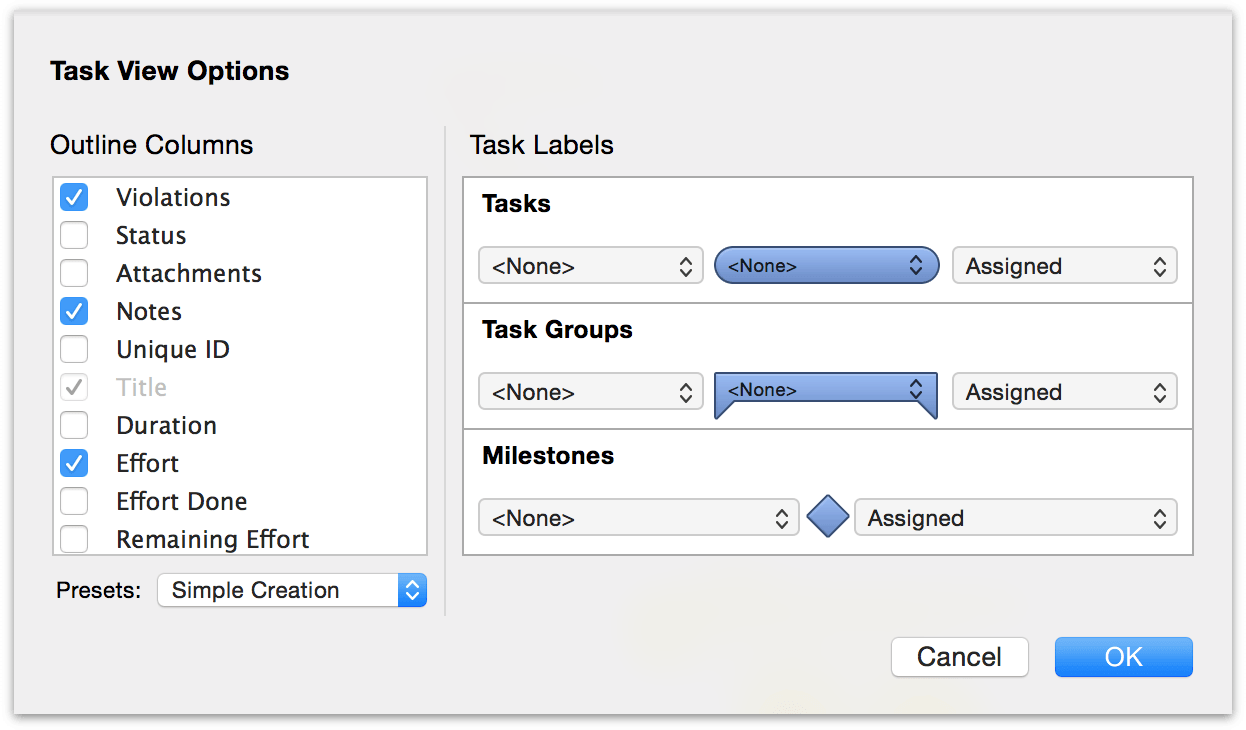Working with Tasks
Tasks are the building blocks of any project: the steps that must be completed on the road to an ultimate goal. OmniPlan provides a suite of powerful tools for customizing tasks — and the relationships between them — to match the exact parameters of your project.
Creating and Deleting Tasks
There are several ways to create new items in task view:
Select an item in the task outline and press Return (or ⌘-Return, depending on the Keyboard Options in OmniPlan’s keyboard preferences).
Click the Add button (plus button) below the outline.
Click the Add button in the toolbar above the outline.
Secondary-click and choose Add ▸ task type from the contextual menu.
There are a few ways to delete a task, milestone, or group:
Select an item in the outline, then press the Delete key.
Select the item, then click the Remove button (minus button) below the outline.
Select the item, then click the Remove button in the toolbar above the outline.
Select the item, then secondary-click to reveal the contextual menu and choose Delete.
Note
If you’re publishing and subscribing, new tasks and changes can come from other users of the project. Use the change tracking sidebar to accept or reject these changes.
Creating Milestones
There are several ways to make a new milestone in task view:
Create a new task, then secondary-click on the task and use the contextual menu to change its Type to Milestone.
Click the Add Milestone button in the toolbar.
Choose Add ▸ Milestone from the action menu below the task outline.
Use the keyboard shortcut ⇧⌘M.
Use the Project Milestone Inspector to manage your milestones and see the critical path leading to each one.
Connecting Tasks with Dependencies
When you have a task which requires something from another task, you can represent their relationship with dependency lines. A dependency line is drawn from the beginning or end of one task (or group, or milestone) to the beginning or end of another.
When you create a dependency, the dependent task automatically reschedules itself to respect the dependency. With further changes to the schedule and leveling, the tasks continue trying to follow the dependencies. If a dependency becomes impossible or you manually make a task stop obeying its dependencies, a violation occurs, and you should resolve it with the Violations window.
There are a few ways to connect tasks:
Select two or more tasks in the outline view or the Gantt chart, then click the Connection toolbar button to create a Finish to Start dependency.
Select two or more tasks in the task outline or the Gantt chart, then click the triangle in the corner of the Connection button—or click and hold the Connection button—to summon a menu of dependency types; choose the type you want.
Put the mouse pointer over a task bar in the Gantt chart, then drag one of the arrows that appears at the beginning or end of the bar. It becomes a dependency line, which you can then drop onto the start or end of another task, group, or milestone. Whether you drag from the start or the end of the prerequisite task, and whether you drop onto the start or end of the dependent task, determines the type of dependency.
In the Dependents or Prerequisites columns of a task, type a dependency or prerequisite code. These codes combine the IDs of the tasks involved and the type of dependency like so:

A Start to Finish dependency from task ID 1
A Start to Start dependency from task ID 1
A Finish to Start dependency from task ID 4.1. (FS is the most common type of dependency, so a task ID by itself without any letters is assumed to be FS.)
A Finish to Start dependency from task ID 4.2, with a lead time of 1 day.
Types of Dependencies
OmniPlan supports four types of dependencies that describe the ways in which tasks relate to one another.
- Finish→Start
- The first task must end before the second task can start; the tasks must not overlap except at the instant the first one ends. This is the most common type of dependency, and the kind that you get when you connect two selected tasks by clicking the Connection button in the toolbar.
- Finish→Finish
- When the first task ends, then the second one can end; the tasks may overlap.
- Start→Start
- Once the first task has started, the second one can start; the tasks may overlap.
- Start→Finish
- Once the first task starts, the second one can finish; the tasks must overlap at least at the instant the first one starts.
Creating Hammock Tasks
A hammock task is a task where the amount of time it takes to complete the task is dependent upon the completion of the task that precedes it and the start of the task that comes after.
For example, if you were to prepare a written document, the time allotted for editing would vary depending on the completion of the document and its due date.
To create a hammock task, first create a finish→start dependency with the preceding task and a start→finish dependency with the task that comes after. (See more on Dependencies for how to create a Start to Finish dependency.)
Then select the the soon-to-be hammock task, and choose Type ▸ Hammock from the gear menu in the bottom bar (or the contextual menu). A task's type can also be changed using the Task Information inspector.
Grouping Tasks
There are a few ways to approach grouping, depending on whether you're starting with an existing set of items you want to add to a group, converting an existing item to a group, or creating a brand new group task.
- To convert a task to a group with new child tasks inside it:
- Select the item you want to grant sub-tasks.
- Choose Add Child Task — ⌘} from the Structure ▸ Add menu.
- The selected item becomes a group with one child task.
- Add more tasks to the group by pressing Return.
- To bring tasks into a group within a peer task above them in the outline:
- Select the items to be grouped.
- Choose Indent — ⌘] from the Structure menu (or Tab, depending on your preference setting).
- The items become children of the item above them in the outline.
- To bring tasks into a newly created group:
- Select the items to be grouped.
- Choose Group — ⌘⌥L from the Structure menu.
- The selected items become children of a newly created group.
- To create a new group with nothing inside it:
- Choose Add ▸ Group from the Structure menu.
- A new, empty group item is created.
- To add items inside the group, open it by clicking the disclosure triangle next to the group name (or its bar in the Gantt chart), and with the group selected, create new tasks as normal.
Characteristics of Task Groups
A task group determines most of its characteristics from the tasks it contains, rather than having characteristics of its own. A group's characteristics can be viewed (and in some cases defined) in the Task inspectors.
Name — Of course, a task group has its own name.
Type — A task group can contain tasks, milestones, and other groups, but its own type is always group. (An empty group has no effort or duration and can serve as a placeholder.)
Effort — The effort of a group is the sum of the effort of all tasks it contains.
Duration — The duration of a group is the amount of time between the beginning of its first task and the end of its last task, not the sum of the durations of all its tasks. If a group contains three one-hour tasks all happening at the same time, the group has a duration of one hour, not three hours.
Scheduling — A group can have a specific start date, which can then affect the start dates of tasks inside it.
Dependencies — A group can have dependencies just like a regular task.
Resource Assignments — If you assign a resource to a task group, the resource gets assigned to all tasks in the group. The group itself can’t have any resources assigned.
Visual Planning in the Gantt Chart
Many attributes of tasks can be edited directly with the mouse in the Gantt chart. When you put your mouse pointer on a task bar, controls appear for manipulating the task.
Changing the Chart’s Scale
You can zoom the Gantt chart (and the resource timeline) in and out using the Magnifying Glass menu in the upper-right corner of the chart, or by putting the mouse pointer in the chart’s header area and dragging left or right, as if you were resizing a column.

Changing the Duration of a Task
To change the duration of a task:

Grab the little traction pad at the right end of a task bar.
Drag the end of the bar left or right to change the task’s duration. You can hold Shift while dragging to snap to round values.
Adjusting Task Completion
To adjust how much of a task has been completed:

Grab the white, house-shaped handle on a task bar.
Drag the handle to update the completion.
Drawing Dependency Lines
To draw dependency lines between one task and another:

Put the mouse pointer over a task bar in the Gantt chart to see the mini dependency lines.
Drag a mini dependency line from the beginning or end of one task.
Drop the line onto the beginning or end of another task to create a dependency.
Drawing Constraints on Tasks
To draw constraints on tasks:

Hold Shift and drag from the beginning or end of a task to create a start or end constraint.
Hold Shift and double-click an existing constraint to remove it.
Locking Start or End Dates
To anchor a start or end date to a fixed point in time:

- ⌘-click a task’s start or end to lock or unlock it.
Changing Item Labels
You can customize the data that appears on the sides and on top of tasks, groups, and milestones in the Gantt chart. Just choose View Options from the View menu and use the pop-up menus on the right side of the View Options panel.
Editing Tasks
Tasks have a lot of details to keep track of. When you select one or more tasks in the task outline, the Task Information inspector shows the task details.
Task Information Inspector
Key attributes that define the type and scope of a task can be edited using the Task Information inspector.

The task Name is the same as the one that appears in the task outline.
You can change the Type from a normal task to a Milestone (a zero-length event which represents an important moment in the project’s life), a task Group (which can contain child tasks), or a Hammock Task (one whose duration varies based on the completion of the preceding task and the start of the task that follows).
Effort is how much total work it will take for this task to be complete. Duration is how much time it will take to get that work done. These can differ based on how many resources are assigned to the task, and the efficiency of the assigned resources. Note that if you enter a number without any units, OmniPlan assumes that you mean the smallest enabled unit in the Project Formatting inspector.
The amount Completed is a percentage of how far along the task is. This is also displayed as shading on the task bar in the Gantt chart. You can adjust this manually by dragging the slider or entering a time in the field.
The task Cost is how much money the task takes to complete. The resources are the per-use or per-hour costs of resources assigned to the task.
Task Schedule Inspector
The Task Schedule inspector describes where the task is positioned in time — both actually, and relative to the baseline — along with other temporal constraints and scheduling priorities.
The Actual start and end dates are when the task really happened during the execution of the project. These can be locked against accidental editing, changes from dependencies, and leveling.
Constraints indicate the earliest a task may begin and the latest it may end. Editable date fields have this calendar icon; click it to summon a mini calendar window you can use to choose a date and time.
The Baseline start and end dates indicate when the task is expected to start and end, according to the original plan. These appear once you use the Set Baseline command on a project.
The Variance shows how much the actual dates differ from the baseline dates. This is calculated automatically; you don’t have to enter it yourself.
Use Scheduling to choose whether the task is scheduled as soon as possible (ASAP) or as late as possible (ALAP).
When leveling, if Splitting is allowed the task may be divided into multiple parts to maximize efficiency of resource use. Otherwise the task will be scheduled as a contiguous time span.
Use the Leveling controls to set a priority for the task; this determines the order in which tasks are assigned resources when leveling. Delay is a value set automatically in the leveling process that notes how long a task has been postponed to wait for resource availability.
Note
ASAP and ALAP scheduling can be set both for individual tasks and at the project level. This is also referred to as setting the direction of the task or project.
While tasks in most projects with defined start dates are scheduled to begin as soon as possible, individual tasks may benefit from ALAP scheduling when completing them later would be advantageous (some marketing work, for example, may benefit from a product being as fully developed as possible before it begins).
Click the Splitting toggle to allow tasks to be automatically split when leveling.
Assign the task a numerical Priority if you want to manually affect the order in which tasks are ordered when leveling. (Also see the priority section of Using Columns in the Task Outline.)
Delay is the amount of time a task has been pushed back from its original scheduled time by leveling.
Using Columns in the Task Outline
Various columns are available for display in the task outline. Set which columns are visible by choosing View Options (⌘J) from the View menu, or secondary-clicking the column headers. Data in these columns corresponds to tasks on the same row in the Gantt chart.

Some of the values in the columns (such as Task Cost) can be edited directly in the outline; others (such as Total Cost) are calculated automatically. Generally, values you can edit in the outline are also editable in the Task Information or Resource Information inspectors.
Use the Arrow keys, or Tab and Shift-Tab (depending the options you've chosen in OmniPlan’s preferences), to move between cells.
Drag column titles left and right to rearrange the columns.
Each key you set up in the Task and Resource Custom Data inspectors becomes available as a column in the outline.
You can sort the selected items in the outline, or all items (if nothing is selected), by using the Sort commands in the Structure menu.
- Violations
- This column displays an icon for each task that has a violation. You can click the icon to summon the Violations window and see what the problem is.
- Status
- This column shows alarm clock icons for tasks that are incomplete and due in the next few days, or in the past. Note that these icons won’t appear if your project has an undetermined start date in the Project Information inspector. Each color of clock has a meaning:
Almost due: this task is incomplete and due in the next 3 work days.
Due: this task is incomplete and due in the next work day.
Past due: this task is incomplete and past due.
- Priority
- You can manually set a priority on a task, to control the order in which tasks are leveled. Priority can be any integer, so you are welcome to decide on the range (1 to 3, 0 to 999, or whatever you like). During leveling, if two tasks are assigned to one resource at the same time, the task with higher priority (expressed as a larger positive number) gets to use the resource first.
Note
When assigning priorities (regardless of the range chosen), the highest priority task is the one with the largest numerical integer assigned. Priority descends from the largest integer, and negative integers are of lower priority than positive.
- Assigned
- This column lists the resources that are assigned to the task.
- Attachments
- You can click the paper clip icon Attachment icon in the selected row to see a menu of the item’s attachments, or to link to a file if there isn’t one linked yet. Rows with links to files show a paper clip icon even when they are deselected.
- Notes
- You can click the note icon in the selected row to show or hide the item’s note, or to create a note if there isn’t one yet. Rows with notes show a note icon even when they are deselected.
- Unique ID
- The unique ID is a number assigned to each task or resource to identify it unambiguously, even if its name or position in the outline changes. A unique ID won’t ever change, and each new task or resource you create gets a new unique ID number. These numbers are useful for matching up items when you are importing and exporting projects between OmniPlan and other applications.
- Free Slack, Total Slack
- These columns display information derived from how the project is set up. Slack is the amount of time a task can be delayed before it must be completed for a subsequent task to begin, or for the project to be completed on time; free slack refers to slack between individual tasks and their subsequent tasks, while total slack refers to the time before an individual task would have an effect on the duration of the project as a whole.
Filtering the Task Outline
When you want to focus on a specific aspect of your project, you can view a subset of its tasks by creating filters for specific criteria. Possible filters include focusing on tasks that were completed in the past week, tasks that are behind the baseline target date by greater than three days, or as in the example below, tasks that are less than 50% complete.

Choose Filter Tasks (⌥⌘F) from the View menu, or click the Filter button in the toolbar. A sheet appears for setting up your filtering criteria. You can add as many criteria as you like by clicking the plus icon on the right side of the entry line, and filter the criteria themselves by option-clicking on the add button to create nested criteria within the filter hierarchy. When your criteria are set up the way you want them, click the Save Filter dropdown menu to save the current filter or restore a previously saved filter. (You can also use the View ▸ Restore Saved Filter menu item.)
When your filter is set, any tasks which match your criteria remain in the outline, while the rest of the project is hidden away. You can work with the project normally while it is filtered, but you can only edit the visible tasks. While your filter is in use the Filter Bar appears, providing options to edit or remove the filter and showing the number of tasks hidden.
If you export or print a project while a filter is on, only the visible tasks are included in the exported file.
Note
Filters are not included when exporting from OmniPlan 2 to the older 1.x version of the OmniPlan file format.
When you’re done, choose Remove Filter from the View menu or click the toolbar button again; all of your tasks reappear, no worse for the wear.
